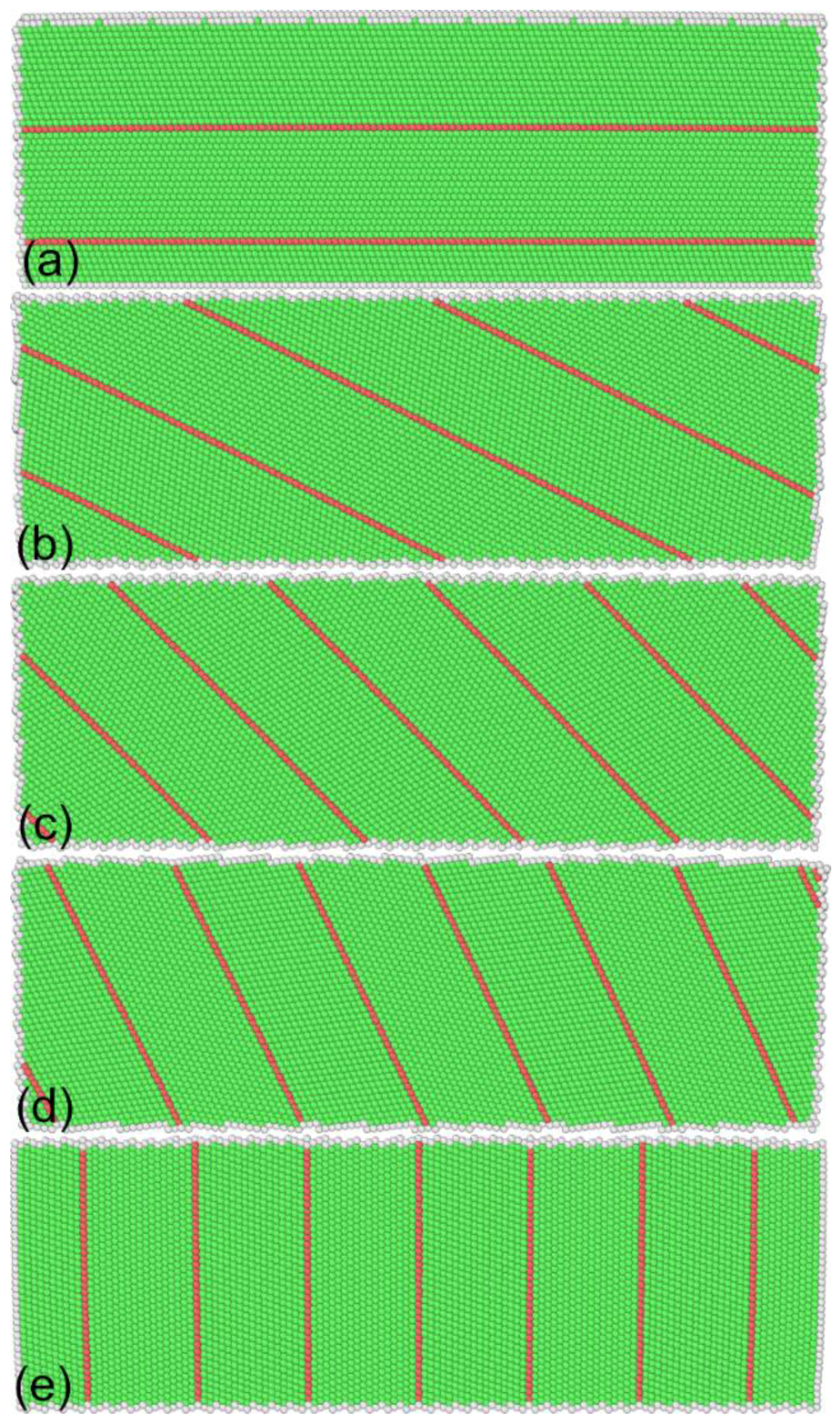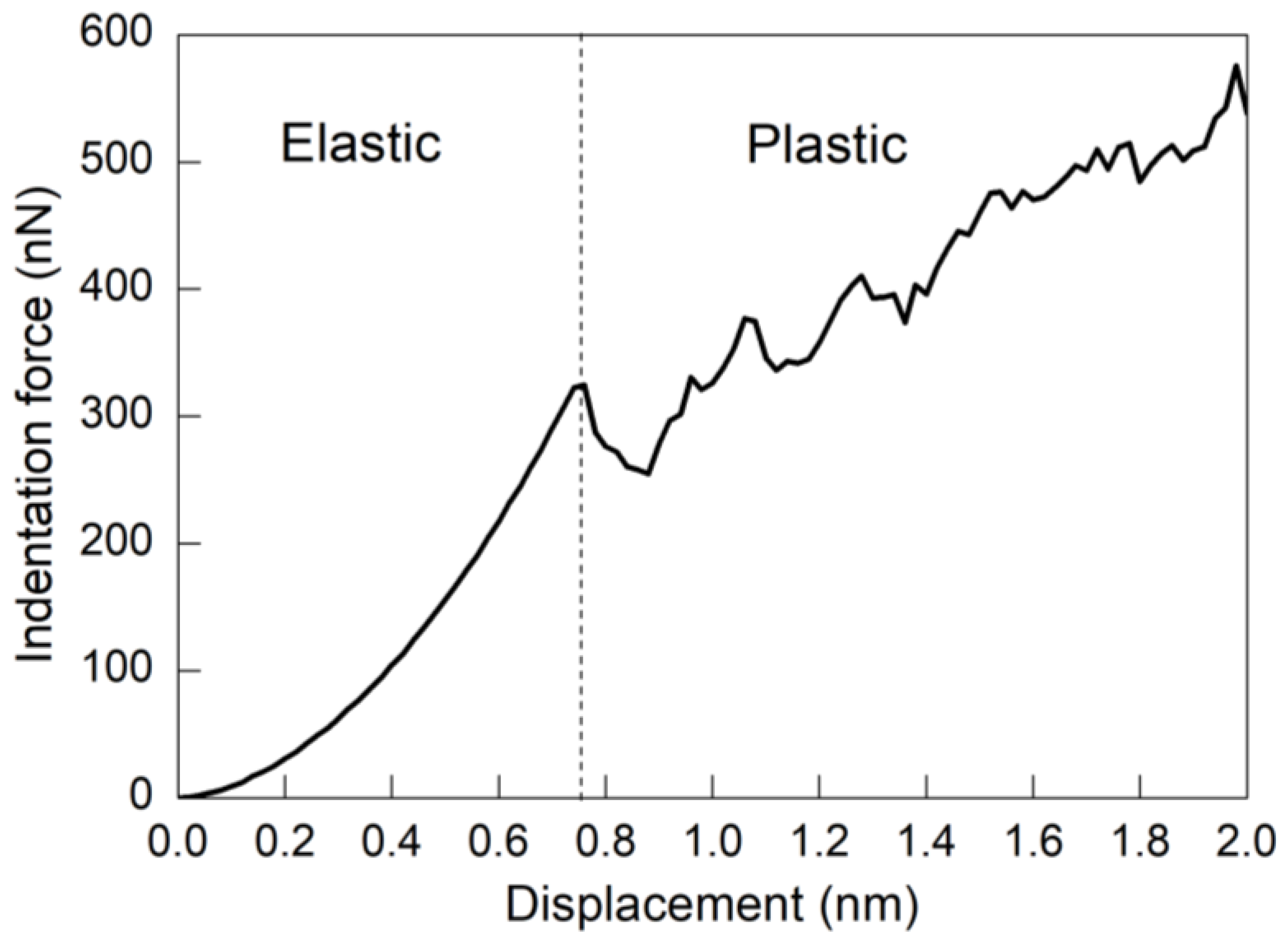Atomistic Investigation of Anisotropic Nanoindentation Behavior of Nanotwinned Aluminum Containing Inclined Twin Boundaries
Abstract
:1. Introduction
2. Simulation Method
3. Results and Discussion
3.1. Deformation Mechanisms
3.2. Influence of Inclination Angles
4. Conclusions
Author Contributions
Funding
Conflicts of Interest
References
- Pharr, G.M.; Oliver, W.C. Measurement of thin film mechanical properties using nanoindentation. MRS Bull. 1992, 17, 28–33. [Google Scholar] [CrossRef]
- Saha, R.; Nix, W.D. Effects of the substrate on the determination of thin film mechanical properties by nanoindentation. Acta Mater. 2002, 50, 23–38. [Google Scholar] [CrossRef]
- Lu, L.; Chen, X.; Huang, X.; Lu, K. Revealing the maximum strength in nanotwinned copper. Science 2009, 323, 607–610. [Google Scholar] [CrossRef] [PubMed]
- Li, X.Y.; Wei, Y.J.; Lu, L.; Lu, K.; Gao, H.J. Dislocation nucleation governed softening and maximum strength in nano-twinned metals. Nature 2010, 464, 877–880. [Google Scholar] [CrossRef] [PubMed] [Green Version]
- Pan, Q.S.; Zhou, H.F.; Lu, Q.H.; Gao, H.J.; Lu, L. History-independent cyclic response of nanotwinned metals. Nature 2017, 551, 214–217. [Google Scholar] [CrossRef] [PubMed]
- Sun, L.G.; He, X.Q.; Lu, J. Nanotwinned and hierarchical nanotwinned metals: a review of experimental, computational and theoretical efforts. npj Comput. Mater. 2018, 4, 6. [Google Scholar] [CrossRef]
- Bufford, D.; Liu, Y.; Wang, J.; Wang, H.; Zhang, X. In situ nanoindentation study on plasticity and work hardening in aluminium with incoherent twin boundaries. Nat. Commun. 2014, 5, 4864. [Google Scholar] [CrossRef] [PubMed] [Green Version]
- Wei, Y.J. Anisotropic size effect in strength in coherent nanowires with tilted twins. Phys. Rev. B 2011, 84, 014107. [Google Scholar] [CrossRef]
- Stukowski, A.; Albe, K.; Farkas, D. Nanotwinned fcc metals: Strengthening versus softening mechanisms. Phys. Rev. B 2010, 82, 224103. [Google Scholar] [CrossRef]
- Brown, J.A.; Ghoniem, N.M. Reversible–irreversible plasticity transition in twinned copper nanopillars. Acta Mater. 2010, 28, 886–894. [Google Scholar] [CrossRef]
- Zhang, J.J.; Hartmaier, A.; Wei, Y.J.; Yan, Y.D.; Sun, T. Mechanisms of anisotropic friction in nanotwinned Cu revealed by atomistic simulations. Model. Simul. Mater. Sci. Eng. 2013, 21, 065001. [Google Scholar] [CrossRef] [Green Version]
- Mishin, Y.; Farkas, D.; Mehl, M.J. Papaconstantopoulos, D.A. Interatomic potentials for monoatomic metals from experimental data and ab initio calculations. Phys. Rev. B 1999, 59, 3393. [Google Scholar] [CrossRef]
- Rautioaho, R.H. An interatomic pair potential for aluminium calculation of stacking fault energy. Phys. Status Solidi B 1982, 112, 83–89. [Google Scholar] [CrossRef]
- Kelchner, C.L.; Plimpton, S.J.; Hamilton, J.C. Dislocation nucleation and defect structure during surface indentation. Phys. Rev. B 1998, 58, 11085–11088. [Google Scholar] [CrossRef]
- Honeycutt, J.D.; Andersen, H.C. Molecular dynamics study of melting and freezing of small Lennard-Jones clusters. J. Phys. Chem. 1987, 91, 4950–4963. [Google Scholar] [CrossRef]
- Plimpton, S. Fast parallel algorithms for short-range molecular dynamics. J. Comput. Phys. 1995, 117, 1–19. [Google Scholar] [CrossRef]
- Stukowski, A. Visualization and analysis of atomistic simulation data with OVITO–the Open Visualization Tool. Model. Simul. Mater. Sci. Eng. 2010, 18, 015012. [Google Scholar] [CrossRef]
- He, Y.S.; Sun, T.; Yuan, Y.; Zhang, J.J.; Yan, Y.D. Molecular dynamics study of the nanoimprint process on bi-crystal Al thin films with twin boundaries. Microelectron. Eng. 2012, 95, 116–120. [Google Scholar] [CrossRef]








| Inclination Angle | Critical Force (nN) | Critical Displacement (nm) |
|---|---|---|
| 0° | 326.5 | 0.76 |
| 26° | 348.3 | 0.96 |
| 45° | 380.8 | 1.06 |
| 64° | 327.1 | 0.91 |
| 90° | 209.0 | 0.70 |
© 2018 by the authors. Licensee MDPI, Basel, Switzerland. This article is an open access article distributed under the terms and conditions of the Creative Commons Attribution (CC BY) license (http://creativecommons.org/licenses/by/4.0/).
Share and Cite
Liu, Y.; Duan, Y.; Zhang, J. Atomistic Investigation of Anisotropic Nanoindentation Behavior of Nanotwinned Aluminum Containing Inclined Twin Boundaries. Nanomaterials 2018, 8, 695. https://doi.org/10.3390/nano8090695
Liu Y, Duan Y, Zhang J. Atomistic Investigation of Anisotropic Nanoindentation Behavior of Nanotwinned Aluminum Containing Inclined Twin Boundaries. Nanomaterials. 2018; 8(9):695. https://doi.org/10.3390/nano8090695
Chicago/Turabian StyleLiu, Yuan, Yanfeng Duan, and Junjie Zhang. 2018. "Atomistic Investigation of Anisotropic Nanoindentation Behavior of Nanotwinned Aluminum Containing Inclined Twin Boundaries" Nanomaterials 8, no. 9: 695. https://doi.org/10.3390/nano8090695
APA StyleLiu, Y., Duan, Y., & Zhang, J. (2018). Atomistic Investigation of Anisotropic Nanoindentation Behavior of Nanotwinned Aluminum Containing Inclined Twin Boundaries. Nanomaterials, 8(9), 695. https://doi.org/10.3390/nano8090695





